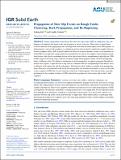Propagation of Slow Slip Events on Rough Faults: Clustering, Back Propagation, and Re‐Rupturing
Author(s)
Sun, Yudong; Cattania, Camilla
DownloadPublished version (3.059Mb)
Publisher with Creative Commons License
Publisher with Creative Commons License
Creative Commons Attribution
Terms of use
Metadata
Show full item recordAbstract
Seismic and geodetic observations show that slow slip events (SSEs) in subduction zones canhappen at all temporal and spatial scales and propagate at various velocities. Observation of rapid tremorreversals indicates back‐propagating fronts traveling much faster than the main rupture front. Heterogeneity offault properties, such as fault roughness, is a ubiquitous feature often invoked to explain this complex behavior,but how roughness affects SSEs is poorly understood. Here we use quasi‐dynamic seismic cycle simulations tomodel SSEs on a rough fault, using normal stress perturbations as a proxy for roughness and assuming rate‐and‐state friction, with velocity‐weakening friction at low slip rate and velocity‐strengthening at high slip rate. SSEsexhibit temporal clustering, large variations in rupture length and propagation speed, and back‐propagatingfronts at different scales. We identify a mechanism for back propagation: as ruptures propagate through low‐normal stress regions, a rapid increase in slip velocity combined with rate‐strengthening friction induces stressoscillations at the rupture tip, and the subsequent “delayed stress drop” induces secondary back‐propagatingfronts. Moreover, on rough faults with fractal elevation profiles, the transition from pulse to crack can also leadto the re‐rupture of SSEs due to local variations in the level of heterogeneity. Our study provides a possiblemechanism for the complex evolution of SSEs inferred from geophysical observations and its link to faultroughness.
Date issued
2025-02-04Department
Massachusetts Institute of Technology. Department of Earth, Atmospheric, and Planetary SciencesJournal
Journal of Geophysical Research: Solid Earth
Publisher
Wiley
Citation
Sun, Y., & Cattania, C. (2025). Propagation of slow slip events on rough faults: Clustering, back propagation, and re-rupturing. Journal of Geophysical Research: Solid Earth, 130, e2024JB029384.
Version: Final published version